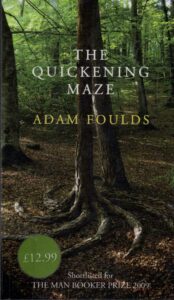Book Title: The Quickening Maze
Author: Adam Foulds
Our journey in umaze involves our constant search of mazes and labyrinths across different domains. We are constantly learning. In this post we share a maze we found in literature. The book we found in our local library is titled “The quickening Maze” and we borrowed it and read it.

This book is an historical fictional novel based on real life events, of people living around the 1840’s. The plot takes place in a private asylum, where people with mental problems were admitted. One of the patients in this asylum was the poet John Clare.
The asylum was run by Dr. Matthew Allen. He and his family lived in a separated house within the asylum’s property. He had a wife, three daughters and one son. Dr. Allen was looking for a new economical venture and he was focusing on producing a machine. Therefore, he was searching for investors for this venture and he involved as investors some of his patients. For example, the poet Alfred Tennyson invested part of his inheritance with Dr. Allen. As Dr. Allen increased his focus on this new venture, it gave the impression that he neglected his work at the asylum that was under his responsibility.
During this period, patients were not properly taken care of, sometimes there were even maltreated by Dr. Allen’s assistant. Some patients worsened during this time. In this period it was particularly evident how John Clare deteriorated during his confinement in the asylum, until he escaped from it and walked back home.
The book describes the life aspiration of different characters, including Dr. Allen, a lonely teenager daughter, the Poet John Clare and other patients. The books describes how the life within the Asylum property was during this period. There are described behaviors, believes and customs from the late 19th century.
If one is not familiar with the historical context of the book, then it might be a difficult read at first. However, if one passed the complication threshold then the book enlightens us with its narrative and descriptions of the Asylum’s life in the 1840’s.
If the reader is aware of the historical context of the book and knows about John Clare, then the book offers a rich contribution to understand the life and circumstances of Clare in this period of time.
If you want to know more about John Clare, you should listen the BBC broadcast from John Clare, who is ‘the greatest labouring-class poet that England has ever produced’
For the reasons given above, the reviews about this book vary as we detect in good reads. For the topic of our blog, we can state, The Quickening Maze does not focus on the description of any particular mazes, instead the concept of mazes emerged from the life stories:
“The maze of a life with no way out, paths taken, places been” p.190


